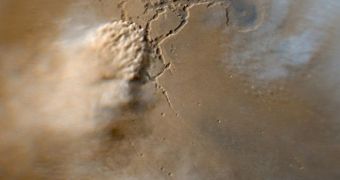For the first time ever, scientists were able to calculate the exact speed of winds within dust devils that form on the surface of the Red Planet. Thus far, investigators were only capable of measuring how fast th devils themselves were moving, but not how fast they were spinning themselves.
These formations kick up a lot of dust as they sweep across the Martian surface, primarily because of the low gravity conditions that exist on our neighboring planet. The Mars Exploration Rover (MER) Spirit itself managed to capture a large number of dust devils on photo.
However, the shots did not necessarily help researchers figure out how fast the whirlwinds were spinning. In the latest study conducted on the issue, investigators used the High Resolution Imaging Science Experiment (HIRISE) instrument aboard the NASA Mars Reconnaissance Orbiter (MRO).
The way the research team approached the study was very thorough, but also lucky. They had the good fortune of operating HiRISE when a dust devil was traveling over the Martian surface underneath.
The group was able to identify certain small features that existed within the storm, and then used high-resolution images to track the position of those features as the whirlwinds were moving along.
This investigation was led by postdoctoral research David Choi, who holds an appointment as a research scientist at the NASA Goddard Space Flight Center (GSFC), in Greenbelt, Maryland.
If we were to draw a comparison with weather events here on Earth, a wind speed above 33 meters (108 feet) per second would be cataloged as hurricane-force. On Mars, winds inside dust devils can travel as fast as 45 meters (148 feet) per second.
However, this speed is variable. Some locations inside the devils can move as slow as 20 to 30 meters (65 to 98 feet) per second. “As a whole, they’re not like a hurricane, but there are pockets or gusts that exceed hurricane-force,” Choi explains, quoted by Universe Today.
Details of the new study were presented on October 3 in Nantes, France, at the joint meeting of the European Planetary Science Congress and the American Astronomical Society’s Division for Planetary Sciences.
HiRISE measurements indicate that the Martian storms are between 150 and 700 meters (492 to 2,296 feet) tall, and cover an area about 30 to 250 meters (98 to 820 feet) in diameter.

 14 DAY TRIAL //
14 DAY TRIAL //